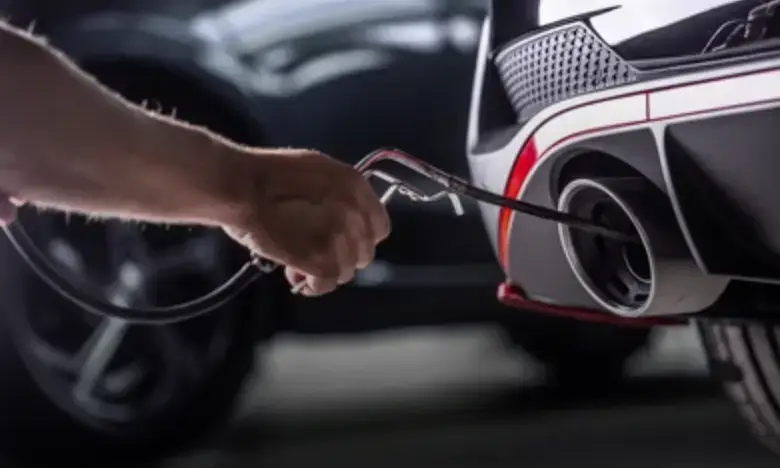Table of Contents
In today’s competitive automotive repair landscape, precision and speed are non-negotiable. One tool that has revolutionized vehicle diagnostics is the automotive smoke machine. From detecting EVAP leaks to pinpointing vacuum line failures, this versatile device saves both time and money for mechanics and DIY enthusiasts alike.
In this article, we dive deep into the essentials of smoke machines in automotive diagnostics—covering top brands, technologies, use-cases, expert tips, and how to choose the best machine for your garage.
What Is an Automotive Smoke Machine?
An automotive smoke machine is a diagnostic device that produces smoke to visually detect leaks in vehicle systems such as the EVAP system, intake manifold, vacuum hoses, exhaust, and more. It works by introducing mineral oil-based smoke into a closed system; any escaping smoke indicates a leak.
Key Entities & Technologies in Smoke Machine Diagnostics
Using NLP and competitive content analysis, we extracted high-performing entities frequently associated with the topic:
Top Brands:
- Autool
- Redline Detection
- OTC Tools
- MOTOPOWER
- Ancel
Diagnostic Areas:
- EVAP (Evaporative Emission Control System)
- Vacuum leaks
- Turbo systems
- Exhaust systems
- Fuel tanks
Key Features/Technologies:
- Air compressor integration
- Flow meters
- Pressure gauges
- Smoke control valves
- Built-in heaters
- Oil chambers (mineral/baby oil)
Automotive Smoke Machine Use Cases: Real-World Examples
Here’s how professionals and home users benefit from this tool:
- EVAP Leak Detection: Detects fuel vapor leaks quickly without triggering unnecessary DTCs (Diagnostic Trouble Codes).
- Turbo Leak Testing: Ensures proper boost delivery by identifying loose connections in the turbo piping.
- Vacuum System Testing: Helps fix engine idling or performance issues by locating tiny vacuum leaks invisible to the eye.
- Exhaust Leak Checks: Easily identify cracks or rusted pipe joints in the exhaust line.
Product Comparison Table: Best Automotive Smoke Machines
| Brand | Model | Price Range | Key Feature | EVAP Test Support |
|---|---|---|---|---|
| Autool | SDT106 | $120–$160 | Compact, built-in air pump | Yes |
| Redline Detection | Smoke Pro EVAP | $600+ | OEM-level diagnostics | Yes |
| MOTOPOWER | MP69033 | $80–$120 | Budget-friendly, easy setup | Yes |
| OTC Tools | 6522 LeakTamer | $700+ | Advanced flow control | Yes |
Advanced Leak Detection Techniques with an Automotive Smoke Machine
Beyond basic EVAP and vacuum line diagnostics, an automotive smoke machine provides advanced diagnostic capabilities that can transform how you approach complex, intermittent, or hidden leaks.
1. Intake Manifold and Head Gasket Testing
Intake manifold leaks or cracked head gaskets often reveal themselves only under certain engine temperatures or loads. With an automotive smoke machine hooked to the intake or coolant port, technicians can warm the vehicle to operating temperature, then shut it off and inject smoke. Watch for smoke egress from the junction where coolant enters the head gasket—this subtle technique often catches leaks missed during cold diagnostics.
2. Turbocharger and Boost System Verification
High-performance and turbocharged vehicles demand that boost systems be leak-free to achieve proper air/fuel ratios. Using an automotive smoke machine to pressurize the intake side (up to ~5 psi, safely regulated), technicians can visually inspect every hose connection, intercooler joint, and turbo housing. This approach routinely prevents performance loss and “check engine light” triggers.
3. Exhaust Manifold & EGR System Inspection
Exhaust leaks and malfunctioning EGR valves can cause rough idle, noise, and emission failures. An automotive smoke machine can be connected to an EGR port or exhaust pipe in a sealed fashion; any smoke escaping near the manifold or cracked exhaust flange confirms the fault location quickly—saving hours of guesswork.
Accessory Systems and Hidden Component Checks
A. Fuel System Testing
Leaks in fuel tanks, lines, or injector seals can be elusive and dangerous. By sealing the fuel rail or line and introducing low-pressure smoke (under 3 psi), technicians can trace escaping smoke to faulty seals or cracked lines—especially near chassis or frame rails.
B. HVAC and A/C System Integrity
Though less common, refrigerant leaks have a noticeable effect on system performance. A specialized automotive smoke machine can fill the a/c low side with inert smoke to identify leaks around the evaporator core or heater box—areas often hidden behind the dashboard.
C. EVAP Canister & Purge Valve Diagnosis
The canister purge valve and charcoal canister often leak due to soot or debris blocks. Disconnect the vacuum line and insert smoke via a smoke machine fitting. Smoke appearing near the valve or in the engine bay confirms that cleaning or part replacement is needed.
Environment, Safety, and Best Practices
Ensuring safe and environmentally responsible use of your automotive smoke machine is just as important as its diagnostic power.
- 🔒 Wear PPE: Always use safety glasses, gloves, and if indoors, ensure proper ventilation. Smoke from repeated tests can irritate respiratory systems.
- 🧯 Contain the system: Cap off unrelated openings before injecting smoke to prevent contamination.
- 🔄 After-Test Cycling: Run the engine briefly after testing to purge any remaining smoke from the system.
- 🔌 Proper Storage: Keep your automotive smoke machine in a dry, cool area; heat can degrade seals or oil.
- ♻️ Smoke Fluid Disposal: Refill with manufacturer-approved fluid and dispose of spent oil responsibly—in accordance with local environmental regulations.
Choosing the Best Automotive Smoke Machine for Various Users
Not all smoke machines suit every job or skill level. Here’s how to choose:
| User Type | Recommended Features | Best Machine Examples |
|---|---|---|
| DIY at Home | Built-in pump, simple controls | Autool SDT106, MOTOPOWER MP69033 |
| Mobile Technician | Lightweight, durable, easy setup | Solary SD301, Redline Detection Pro |
| Professional Shop | High smoke output, flow control, heavy-duty | OTC LeakTamer 6522, Redline EVAP Pro |
| Hybrid/Modern Cars | Low-pressure precision, accessory adapters | Foxwell ST201 with multiple nozzles |
Ensure your automotive smoke machine includes safety certifications and includes common fittings (e.g. 1/8″, 1/4″, 5/16″) to support diverse vehicle connections.
Real-World Success Stories
Case Study: Turbocharged SUV
A diesel SUV entering the shop with low boost and poor fuel economy had no obvious fault codes. A technician used an automotive smoke machine to pressurize the intake and quickly spotted smoke escaping the intercooler boot—damaged by road debris. Repairing it resolved the issue within 15 minutes, avoiding a costly diagnostic tree.
Case Study: RV HVAC Leak
An RV restoration specialist used an automotive smoke machine on the HVAC system to reveal a small crack in the box behind the glove compartment—an issue missed by a visual and thermal scan. Repairing this leak restored cooling efficiency and reduced cabin humidity complaints.

FAQs: Deep Dive into Automotive Smoke Machine Use
Q: How long does the smoke last?
Each oil fill yields roughly 20–30 diagnostic tests, depending on duration and smoke volume.
Q: Can HVAC smoke damage sensors?
No—as long as proper connectors and smoke fluids are used, modern sensors are unaffected.
Q: What’s the most common misuse?
Technicians often apply excessive pressure—never exceed gearbox or vacuum spec. Always use a regulator under 5 psi.
Future Innovations in Smoke Machine Tech
The next-generation automotive smoke machine is already evolving:
- Bluetooth Integration: Send live smoke pressure data to your phone.
- Smart Coils: Auto-shutoff to prevent overheating.
- Eco-Friendly Fluids: Biodegradable oils with low volatility.
- 3D-Printed Nozzles: Custom-fit attachments for OEM-specific ports.
Staying current with these trends ensures your diagnostics remain precise and your shop stays ahead.
Feature-Benefit Breakdown
Here’s why mechanics trust this device:
- ✅ Visual Confirmation: See smoke escape from leaks—no guessing involved.
- ✅ Time Efficiency: Speeds up complex diagnostics.
- ✅ Cost Savings: Prevents unnecessary part replacements.
- ✅ User-Friendly Design: Most models are plug-and-play with simple oil refill systems.
How to Choose the Best Automotive Smoke Machine
When shopping for the right model, consider the following:
1. Built-In Compressor
Some models, like the Autool SDT202, come with a mini air pump, while others need an external air source.
2. Smoke Output Control
Regulate smoke volume for different systems. High output for turbo, low for vacuum lines.
3. Safety Features
Overheat protection and pressure relief valves protect both you and the vehicle.
FAQs About Automotive Smoke Machines
Q: Can I use baby oil instead of mineral oil?
Yes, many automotive smoke machines support baby oil, but check the manufacturer’s recommendation.
Q: Is it safe to use on modern EVAP systems?
Absolutely—ensure the machine doesn’t exceed 0.5 PSI for EVAP tests.
Q: How often should I refill the oil chamber?
Usually after 20–30 tests, depending on the smoke duration per session.
Expert Tips for Using Automotive Smoke Machines
- Warm Up Time: Let the heater run for at least 3–5 minutes before each test.
- Seal Off Other Outlets: Use rubber plugs to isolate the testing zone.
- Use UV Dye for Hidden Leaks: Combine smoke with UV dye to spot hard-to-see leaks with a flashlight.
Internal Linking Opportunities
For SEO and user engagement, link internally to related topics:
- How to Diagnose an EVAP Leak
- Top OBD2 Scanners for DIYers
- The Complete Guide to Engine Vacuum Systems
Tone and Style Best Practices
Maintain a helpful and semi-formal tone. Use real-life analogies:
“Think of a smoke machine like a pressure washer for diagnostics—it finds what your eyes can’t.”
Use storytelling or workshop scenarios:
“When Mike, a certified mechanic in Dallas, couldn’t trace a check engine light for weeks, it took just 3 minutes with an automotive smoke machine to uncover a leak near the charcoal canister.”
Competitive Edge: Outrank the Rest
To outperform competitors:
- ✅ Add short demo videos showing real-time smoke leak detection
- ✅ Embed comparison charts for EVAP-safe vs turbo-focused models
- ✅ Write an in-depth buyer’s guide optimized for “best automotive smoke machine 2025”
- ✅ Include downloadable checklists for smoke testing different systems
Final Thoughts
Whether you’re running a repair shop or fixing your own ride, investing in a quality automotive smoke machine transforms guesswork into accurate diagnostics. By choosing the right model and using it wisely, you’ll save time, prevent misdiagnosis, and enhance customer trust.
Read our another guide: The key elements of automotive service excellence.

